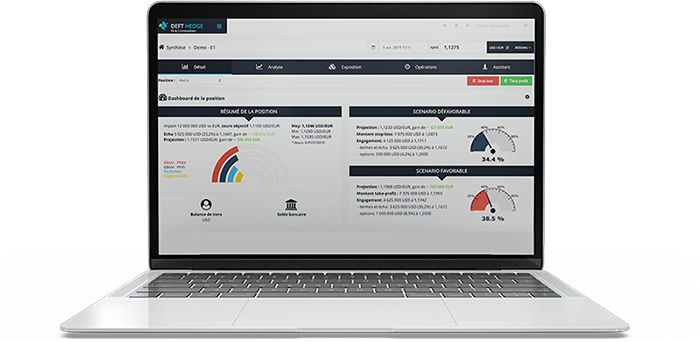Foreign exchange loss and accounting.

Whenever you carry out transactions in foreign currencies, you are confronted with the problem of fluctuating currency values. Over more or less long periods of time, the rate of a currency can fluctuate significantly and have significant effects on your balance sheet.
In order to best anticipate currency fluctuations, it is therefore important to adopt an effective buying and selling strategy in foreign currencies.
To help and support you in the execution of your foreign exchange transactions, DeftHedge offers you a SaaS solution particularly adapted for professionals who need to manage foreign exchange transactions.
In order to reduce your foreign exchange losses, adopt an effective strategy of protection against foreign exchange risks.
What is a foreign exchange loss ?
In order to avoid an exchange rate loss, it is therefore advisable to analyse the economic situation as closely as possible and to protect yourself against exchange rate risks.
A foreign exchange loss occurs when the evolution of the value of one currency in relation to another is unfavourable to the selling company. The loss on sale is visible when the transaction is settled at a lower rate than when the selling company recorded the transaction in its accounts.
Depending on changes in the value of currencies, this exchange loss can have a significant impact on the company’s income statement.
How to calculate an exchange rate loss ?
Like the exchange gains, exchange losses are calculated for each accounting year of a company. In order to know the amount of the exchange loss, it is necessary to recalculate the monetary element at the exchange rate in force when the accounting year is closed.
The amount obtained with the currency conversion will then be accounted for in the different accounts that make up the company’s fiscal year.


How do you account for the exchange loss ?
In order to make exchange gains and losses clearer, the General Chart of Accounts (GCA) has been amended. From 1 January 2017, exchange gains and losses must therefore be detailed in different accounts:
- Account 656: Exchange losses on trade receivables and payables
- Account 666: Exchange losses on receivables and payables
- Account 756: Exchange gains on trade receivables and payables
- Account 766: Exchange gains on financial receivables and debts
The detailed recording of foreign exchange gains and losses thus makes it possible to see the impact of the fluctuation in the value of currencies.
What is an active translation difference ?
At the end of the financial year, you must convert foreign currency receivables and payables into euros. This conversion will be based on the last exchange rate in force at the time of closing.
This may result in an asset or liability translation difference.
For more information, see : accounting and exchange rates
Depending on changes in exchange rates, the translation difference may therefore be an asset or a liability:
- An asset: an unrealised loss reflecting a decrease in receivables and an increase in liabilities.
- A currency translation adjustment liability: an unrealised gain reflecting a decrease in debts and an increase in receivables.
When the amount of the debts is different from the amount shown in the accounts, an active translation difference therefore appears in the company’s accounting result.
Conversion and registration procedures
Article 420-7 of the French General Chart of Accounts authorises companies to record their foreign currency transactions in an account specifically dedicated to foreign currency transactions.
This foreign currency account is freely managed by the company but must necessarily be converted at the end of the financial year.
The conversion of the various amounts recorded can be done in two different ways:
- Immediate conversion: based on the exchange rate of the day of the transaction or based on the fixed or average rate.
- Conversion at the end of the financial year: via liaison accounts that allow currencies to be linked.
The recording of foreign currency transactions in a separate account therefore facilitates the management and organisation of your accounting. In fact, the company will only have to convert the sums, either directly or at the end of its accounting year.
Avoid exchange rate losses with DeftHedge
Good accounting management is an essential element for any company, especially when you have to carry out foreign exchange transactions. Indeed, when you are on an international market, you are confronted with exchange rate risks.
If the evolution of the exchange rate is to your disadvantage, the results of your various foreign currency transactions can be strongly impacted. In order to minimise exchange rate losses, you can therefore use DeftHedge’s SaaS solution, specially designed for companies carrying out foreign exchange transactions.
With our currency management solution, you will be able to automate many accounting tasks and focus on the best strategy for your international operations.
Our management tool allows you to be perfectly informed about your accounting and offers you the possibility to simulate different strategies in order to choose the most interesting one. Thanks to the extensive information available on DeftHedge, you will be able to considerably improve your strategy and reduce your foreign exchange losses.
On a daily basis, our SaaS solution will become indispensable in the management of your company.
